#Textile Auxiliaries
Explore tagged Tumblr posts
Text
Hindprakash Chemicals Pvt. Ltd. | Leading Manufacturer of dyestuffs, textile auxiliaries
Hindprakash Chemicals is India’s trusted manufacturer and exporter of high-quality dyestuffs, dye intermediates, pigments, resins, and chemicals, serving industries worldwide with innovation and sustainability since 1942.

0 notes
Text
Textile Auxiliaries Market Competitive Breakdown and Regional Forecast by 2031
The “Textile Auxiliaries Market Share, Size, and Trends | 2031” is market research by The Insight Partners. The Textile Auxiliaries market has perceived tides of change in the recent past. This study offers precise projections after detailed scrutiny of a range of factors impacting the business. Considering the present market scenario, this report brings forward correct predictions on revenue, market size, and CAGR of the Textile Auxiliaries market. The novel market research which is based on a fact-based foundation is now accessible for purchase. This report can make a variance in wide decision-making and drive business forward in the right direction.
Business is no longer a game of instincts when it comes to capitalizing on new production lines. In a highly competitive Textile Auxiliaries market, companies may face several challenges. Having trusted market research is always endorsed for both veteran and new entrants. Textile Auxiliaries Market report presents a thorough analysis of local, regional, and global market scenarios through the following details.
Report Attributes
Details
Segmental Coverage
Product
Pretreatment Agents
Dyeing and Printing Agents
Finishing Agents
Spin Finish
Knitting and Weaving
Other Auxiliaries
Application
Home Furnishings
Technical Textiles
Apparel
Industrial Textiles
Regional and Country Coverage
North America (US, Canada, Mexico)
Europe (UK, Germany, France, Russia, Italy, Rest of Europe)
Asia Pacific (China, India, Japan, Australia, Rest of APAC)
South / South & Central America (Brazil, Argentina, Rest of South/South & Central America)
Middle East & Africa (South Africa, Saudi Arabia, UAE, Rest of MEA)
Market Leaders and Key Company Profiles
Huntsman International LLC
Solvay
Archroma
Dow Chemicals
ZSCHIMMER & SCHWARZ
Fibro Chem LLC
Evonik Industries AG
Fineotex Group
Camex Ltd.
Croda International Plc
Other key companies
Competitive Landscape
Knowing the state of rivals is a strategically right move to outperform them. This report is the right place to explore key strategies, developments, and recent launches by key Textile Auxiliaries market players. This report emphasizes an analysis of business strategies and expected growth opportunities for brands.
Key Coverings:
Current and Future Market Estimates- Textile Auxiliaries Market Share, CAGR, and Forecast | 2031
Market Dynamics – Drivers, Challenges, Regional Trends, and Market Opportunities
Market Segmentation – Product, Application, End-use Industries, and Regional Growth Prospects.
Competition Matrix – Key Market Players and Strategies
Recent Developments and Innovation Contributing Market Growth
Need a Customized Market Research Report?
You can always share any specific requirements that you have, and our team will adjust the scope of research offerings as per your needs.
The following are some customizations our clients frequently ask for:
The Textile Auxiliaries market report can be customized based on specific regions/countries as per the intention of the business
The report production was facilitated as per the need and following the expected time frame
Insights and chapters tailored as per your requirements.
Depending on the preferences we may also accommodate changes in the current scope.
Key Questions Addressed in the Textile Auxiliaries Market Research Include:
What are present Textile Auxiliaries market values, and what can be expected in the upcoming decade?
What are the key segments in the Textile Auxiliaries market?
What is the regional distribution of the Textile Auxiliaries market report?
What are the key players and their recent strategies?
What are the key factors driving Textile Auxiliaries market growth?
What are regulatory concerns and requirements businesses have to compel?
About Us:
The Insight Partners is a one-stop industry research provider of actionable intelligence. We help our clients in getting solutions to their research requirements through our syndicated and consulting research services. We specialize in industries such as Semiconductor and Electronics, Aerospace and Defense, Automotive and Transportation, Biotechnology, Healthcare IT, Manufacturing and Construction, Medical Devices, Technology, Media and Telecommunications, Chemicals and Materials.
Contact Us: www.theinsightpartners.com
0 notes
Text
Auxiliaries for Textile Industry in Delhi | Textile Chemicals
Auxiliaries For Textile Industry In Delhi
Are you in search of high-quality auxiliaries for the textile industry? Look no further! Welcome to our premier service for textile auxiliaries in Delhi. The textile industry encompasses a wide array of materials, from yarns to various fabrics, fibers, and finished articles. Each requires specialized solutions for their chemical processing, and we are here to provide exactly that. Our range of products is diverse, catering to the unique needs of textile manufacturers. textile auxiliary producer Delhi
Why Choose Us?
As leading textile auxiliaries manufacturers in Delhi, we pride ourselves on several key points:
Diverse Product Range: We offer more than just a single product; our catalogue boasts a wide variety of auxiliaries for chemical processing.
Versatility: Our products cater to a range of fabrics and fibers, ensuring we are not limited to one specific type.
Quality: All our products are of exceptional quality, designed for optimal performance and excellent results.
Multi-Purpose: Whether it's dyeing, printing, or other fabric treatments, our auxiliaries are versatile and effective.
Comprehensive Solutions: Consider us your one-stop solution for all textile processing requirements.
These aspects set us apart as premier textile auxiliary producers.
Our Categories of Auxiliaries
Here's a glimpse into some of the textile industry auxiliaries we offer in Delhi:
Pretreatment Auxiliaries
Our pretreatment auxiliaries boast highly absorbent and low-foaming formulations, with impressive binding capabilities. They are eco-friendly, GOTS approved, and free of APEO/NPEO. Examples include Scowet TT Conc., Rikoclean – STR, and Trinitron. These auxiliaries include stain removers tailored for synthetic and natural fibers, such as Rikoclean – STR.
Dyeing Auxiliaries
Our dyeing auxiliaries feature excellent levelling properties, ensuring uniform distribution of dye. They offer high soaping and washing-off abilities, all while being GOTS approved. For instance, Milaniaks- R serves as a cationic retarder for controlled and uniform acrylic dyeing. Additionally, Trinitron – LTS is a low-temperature washing off agent suitable for various fibers, providing excellent soaping fastness and easy wash.
Finishing Agents
Our finishing agents consist of both silicone and non-silicone specialty softeners, crafted to meet the industry's specific needs. These auxiliaries are invaluable, offering versatile finishes tailored to the desired garment or fabric. From exhaustible to inexhaustible finishes, as well as hydrophobic and oleo phobic options, our range covers a spectrum of textile chemicals and auxiliaries in Delhi.
If you're in need of top-notch textile auxiliaries, don't hesitate to reach out to us today. We are your partners in achieving exceptional textile processing results.
#auxiliaries for textile industry in Delhi#textile auxiliaries manufacturers Delhi#textile auxiliary producer Delhi
0 notes
Text

Textile Dyeing Chemicals & Auxiliaries | Dyeing Agent - Sarex
0 notes
Text
How Textile Chemical Dyes Impact the Environment?
In the vibrant world of fashion and textiles, colors play a pivotal role in capturing our imagination and defining our sense of style. The captivating hues of our garments owe their brilliance to a significant yet often overlooked aspect of the industry: chemical dyes.
These dyes have revolutionized the textile sector, making it possible to produce a wide array of colors and patterns that appeal to consumers' ever-changing tastes. However, amidst this rainbow of possibilities lies a dark truth - the environmental impact of textile chemical dyes.
In this blog, we delve into the consequences of using chemical dyes in textile production and explore sustainable alternatives that can help mitigate the ecological footprint of the fashion industry.

Water Pollution
One of the most significant environmental concerns associated with chemical reactive dyes in textiles is water pollution. Conventional dyeing processes often involve large amounts of water, which is used to rinse and treat fabrics. As a result, vast quantities of chemically-laden wastewater are discharged into rivers and water bodies, contaminating aquatic ecosystems. Many of these dyes are non-biodegradable and can persist in the environment for decades, disrupting the natural balance and threatening the health of aquatic organisms.
Energy Consumption
The process of digital textile sublimation inks requires substantial energy inputs, primarily during the dye application and fixation stages. Traditional dyeing methods may involve high-temperature dye baths and extended processing times, adding to the industry's carbon footprint. The energy-intensive nature of these processes contributes to greenhouse gas emissions, accelerating climate change and its devastating consequences.
Toxic Chemical Exposure
Chemical dyes used in textile auxiliaries manufacturers often contain hazardous substances such as heavy metals, formaldehyde, and volatile organic compounds (VOCs). Not only are these substances harmful to the environment, but they also pose significant health risks to the workers in the textile industry who are exposed to them daily. Moreover, consumers may experience allergic reactions and skin irritations when in contact with garments containing residual dye chemicals.
Biodiversity and Land Contamination
When dye wastewater finds its way into the soil, it can have severe consequences for terrestrial ecosystems. The toxic substances from the dyes can leach into the soil, affecting soil quality and disrupting the delicate balance of local flora and fauna. Moreover, the disposal of waste from dyeing processes can lead to the accumulation of harmful chemicals in landfills, further exacerbating the environmental impact.
Scarce Resource Consumption
Many chemical dyes rely on non-renewable resources for their production. For instance, some synthetic dyes use petroleum-based derivatives, placing additional strain on dwindling fossil fuel reserves. As these resources become scarcer, the textile industry must find more sustainable alternatives to safeguard the planet's future.
Embracing Sustainable Solutions
As we confront the ecological consequences of chemical dyes, the textile industry is gradually recognizing the urgent need for change. Embracing sustainable solutions can help mitigate the impact of dyes on the environment:
Natural Dyes: Traditional plant-based dyes, such as indigo, turmeric, and madder, offer a biodegradable and eco-friendly alternative. They can be sourced sustainably, reducing the strain on the environment.
Waterless Dyeing Technologies: Innovative technologies, like air dyeing and digital printing, minimize water usage and eliminate the discharge of wastewater, significantly reducing water pollution.
Biodegradable Dyes: Researchers are developing biodegradable dyes that break down naturally over time, circumventing the issue of persistent chemicals in the environment.
Eco-Friendly Dyeing Processes: Manufacturers can adopt low-impact dyeing techniques that consume less energy and minimize toxic chemical usage, ensuring a cleaner and safer environment for all.
The use of chemical dyes offers by textile printing ink exporter in the textile industry has undoubtedly made fashion more colourful and accessible. However, this innovation comes at a high cost to our environment. From water pollution to biodiversity loss, the impact of chemical dyes on the planet is far-reaching.
To ensure a sustainable future, it is imperative for the industry to embrace eco-friendly alternatives and implement responsible dyeing practices. By taking steps towards a more environmentally conscious approach, we can paint a brighter, greener canvas for the fashion world, where creativity and conscience coexist harmoniously.
#Textile Dyes Exporter#Textile Dyes Manufacturers#Textile Dyes Manufacturers in India#Digital Textile Reactive Inks#Digital Textile Printing Ink Manufacturer#Digital Textile Printing Ink Exporters#Textile Printing Ink Exporter#Digital Textile Sublimation Inks#Textile Auxiliaries Manufacturers#Textile Auxiliaries Exporter#Reactive Dyes Manufacturer#Reactive Dyes Exporter#Reactive Dyes Manufacturer in India#Textile Chemical Dyes
0 notes
Text
There’s no chaos, there’s no drama…

Chaos and drama are Ed’s baseline.
His childhood home.
His experiences on Hornigold’s ship.
Probably the early days as Blackbeard as Ed built a reputation.
And then Ed became so talented at creating the theatre of fear, controlling the chaos and drama to his own ends, he was able to cocoon away, and for a time was probably glad not to feel it directly…
‘The feel of not to feel it When there is none to heal it…’
And now Ed’s numb.
Because it’s all Ed’s known; his brain is built around it. The adrenaline, the cortisol. Without it he feels hollowed out, a ghost.
But think of what Ed’s asking for. Chaos - disorder, panic, confusion. Ed thinks he would rather feel such emotions than safety. He’d rather die in the sturm and drang than live in ennui. Because it’s familiar. He doesn’t know there is anything else. Chaos is familiar, boredom is death.
But Ed doesn’t really want chaos and drama. He wants novelty, serendipity, originality. And he wants love - to receive and experience it. It’s just Ed has only felt the centres of his brain light up by the negative. What he begins to realise on Stede’s ship, and then through meeting Stede, is that the same (better) stimulus can occur from positive experiences.
Ed’s immediately drawn to the knickknacks, overkill, and lunacy. You see the awe and wonder at the auxiliary wardrobe. The delight at finding someone to play dress up. The seventh heaven of the lighthouse fuckery. The dizzy delight of that damn good marmalade. The relief of unburdening to someone who cares. And it just keeps getting better… beautiful clothes, moonlight compliments, conversation and foot-kicking, lazy breakfasts, flirty swordplay, nighttime story-telling, treasure hunts, co-captain brandies… it’s all hitting Ed’s amygdala over and over.
And at the centre of it all is Stede understanding every part of Ed intuitively. Stede explains, ‘Guys like Blackbeard live for adventure… it’s like nourishment for them.’ But Stede doesn’t plan a raiding party, he plans a day of fun. He understands how Ed needs variety better than Ed.
When Stede leaves, Ed tries so hard to recreate the feeling through food and textiles and an on-deck sing-song, but returns to the chaos and drama after being made to feel unworthy, unsafe of any other life. It’ll never again be enough, though. It wasn’t enough before; just a holding place for where a real life could’ve, should’ve been, and Ed knows that now.
In the end, Ed doesn’t choose drama and chaos - he actively revolts against it because he realises it’s killing him. Instead Ed chooses a quiet life in an inn in some backwater with Stede. It’s enough.
The slow whimsy and delight in the everyday is what Ed learns to appreciate. As Roach says, ‘We eat, but how often do we taste?’. Ed can find novelty in the ordinary because Stede knows how to see idiosyncrasy in the seemingly mundane. After all, a successful raid is returning with a half-dead plant now displayed in pride of place.
Stede’s the god of small things really, and whilst he does have an eye for the extravagant, his baseline is set in the minutiae. Stede can inspire wonder in a shared cup of tea. And that’s what Ed needs - to watch the clouds and sunset for the beauty, and feel the quiet wonder of everyday life.

102 notes
·
View notes
Text

Roman Phallus Pendant Unearthed at Vindolanda
Excavations at Vindolanda near Hadrian’s Wall have unearthed a miniature phallus pendant.
Vindolanda, meaning “white field” or “white moor,” was a Roman auxiliary fort guarding the Stanegate road just south of Hadrian’s Wall.
Between AD 85 and AD 370, no fewer than nine timber and stone forts were built on the site, making Vindolanda one of Britain’s most complex archaeological sites and a time capsule of Roman military life on the frontier.
Vindolanda remains an active archaeological site (celebrating their 55th anniversary of being the Vindolanda Charitable Trust), where excavations have uncovered thousands of remarkably preserved shoes, textiles, wooden artefacts, and the famous Vindolanda tablets – the oldest surviving written documents from Roman Britain.
In the latest season of excavations, archaeologists have unearthed a miniature phallus pendant made from jet in the remains of a 4th century wall.
The Roman’s believed that the phallus was the embodiment of the masculine generative power and provided protection, fertility, and good fortune. Phallic imagery appears throughout the Roman world—in sculptures, mosaics, frescoes, and portable items such as pendants and bullae.
Along the corridor of Hadrian’s Wall alone, there are 59 known phalli in various forms, whether incised, relief, or sculpture depictions that are grouped into nine morphological traits: the rocket, the hammer, the kinky-winky, the splitcock, the pointer, the double-dong, running hard, the beast, and the lucky dip.
The miniature phallus pendant follows on from a 2024 discovery at Vindolanda where archaeologists discovered a phallus symbol carved into a stone slab.
The 2025 excavations are a continuation of a research project from 2024 to 2028 that focuses on the last remaining turfed area within the boundaries of the final stone fort constructed at Vindolanda.
By Mark Milligan.
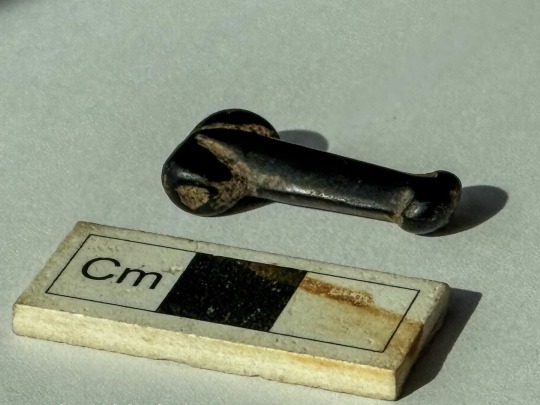
#Roman Phallus Pendant Unearthed at Vindolanda#Roman auxiliary fort#Hadrian’s Wall#ancient jewelry#ancient artifacts#archeology#history#history news#ancient history#ancient culture#ancient civilizations#roman history#roman empire#roman art
78 notes
·
View notes
Text
Women found temporary, often short-lived support for the notion of their innate equality with men as creatures of God in the heretical sects. Women in great numbers were active in organizing and proselytizing for the heretical sects and were visible among those suffering persecution and martyrdom. In this, they followed a pattern already noted in the history of early Christianity: as long as movements were small, loosely structured and persecuted, women were welcomed as members, given access to organizational leadership and shared authority with men. When the movement became successful, it became more tightly structured, more hierarchical and more male-dominated. Women were then relegated to auxiliary roles and to invisibility. This can be illustrated by the case of the Cathars.
The Cathar heresy flourished in the 11th century in the Languedoc and in the 12th century continued there and spread into Italy, the Rhineland and the Low Countries. Its dualistic belief system rested heavily on Gnostic texts and interpretations. Cathar doctrine taught that there were two distinct gods, one the creator of good, the other of evil. The material world was created by the evil god and its reproduction was by definition evil, hence Cathars rejected marriage and what they defined as the fruits of copulation, meat and milk. Since sin originated in Satan, Cathars held Eve blameless in the Fall; they saw her merely as Satan's tool. Following Gnostic doctrine, Cathars believed that Mary Magdalen had been the wife or concubine of Christ. They denied the doctrine of physical resurrection and held that resurrection referred purely to the soul. It was the evil god that created male and female; in the heavenly kingdom all creatures would be angels without earthly sexuality. These doctrinal differences from Catholic orthodoxy enabled Cathars to see men and women as more alike than different in the divine purpose and in their religious potential. Cathars believed that it was possible for human beings to come closer to perfection through ascetic living; those who succeeded were called perfecti; both men and women could reach that stage. In practice most people reached that stage only shortly before their death. While marriage was tolerated for the ordinary believer, it was forbidden to perfecti and perfectae. One reached that stage through the ceremony of the consolamentum, a sort of baptism by the laying on of hands. This meant that ordinary believers had a great deal of freedom in sexual matters during their lifetimes, since they were assured that after confession and receiving the consolamentum they would be perfected and saved. It is significant for the high status of women among the Cathars that, at least in theory, men and women could administer the consolamentum, although in practice few women ever did.
Catharism developed in the cities of the Languedoc, especially in Toulouse, the center of textile production and trade. Large numbers of women in the textile manufacturies became Cathars, as did male artisans and textile workers. Since the wages of female textile workers were much below those of male workers, even fully employed women could barely support themselves. To such women Catharism may have offered hope of salvation and practical communal support. The disproportionately large number of females among these heretics was noticed even by contemporaries.
A number of Languedoc noblewomen are known as leaders of Catharism and as perfectae. Phillipa, wife of the Count de Foix, led a convent of perfectae; one of the count's sisters was Esclarmonde de Foix, the "Princesse Cathare." After the death of her husband, she returned to the court of her brother, who built a house in which she, his former wife and other perfectae lived. In 1207 there was a public dispute between several bishops and representatives of Waldensians and Cathars. It is indicative both of her high status and of the limitations of her position that Esclarmonde participated in this public dispute on the side of the heretics and that the bishops reprimanded her and told her to go back to her spinning.
In the second half of the 12th century many Cathar women's convents were founded for unmarried daughters and widows of the lower nobility. These communities, led by perfectae, were under the spiritual guidance of a heretical bishop. While these Cathar women, like Catholic nuns, were active in education, spinning and weaving, they also proselytized and performed some religious ceremonies.
Constant persecution of the Cathars by the Inquisition made severe inroads in the strength of the movement. The violence of the Albigensian crusade of 1209 fell with particular brutality upon women. That year there was a massacre of heretic women and children in Beziers, and a year later, in Minerve, Cathars were given a choice of abjuring their belief or burning. One hundred forty male and female Cathars jumped into the flames. When crusaders started a reign of terror against the perfectae, the local population at times defended the heretics. In 1234 in several communities, armed women and other citizens prevented the arrest of female heretics. In 1243 women actively fought in defense of Montsegur castle, the last stronghold of the Cathars. During the siege almost all the noblewomen in the castle made a pact with the bishop to give them the consolamentum in case they were wounded and could not speak. The agreement was fulfilled when the situation in the fortress became hopeless. After the defeat, the military defenders of the fortress were allowed to retreat unharmed, but 200 male and female Cathars were burned on a great pyre, among them a number of well-known perfectae. After Montsegur the nobility largely withdrew from Catharism, and Cathar convents gradually disappeared.
By the end of the 13th century, Inquisition records no longer mention perfectae, which indicates that they lost their leadership position in the sect. In its declining phase Catharism attracted more adherents of the urban middle classes. Members of the middle class were drawn to Catharism because it allowed profit and interest, which the Church opposed. The Cathar women among this group appear in the record as among the faithful, but not as leaders. They supported the movement by raising funds, giving help to fugitives and doing missionary work. With the destruction of the Cathar convents the opportunity for women to exercise autonomous power and even political leadership disappeared. Many former perfectae joined the Beguines; others found refuge in Catholic convents. By the middle of the 14th century, Catharism had virtually disappeared. As would happen so often later in revolutionary and heretical movements, Catharism had seemed to promise women a role of spiritual and theological equality. Under the impact of persecution and of middle-class respectability this promise had given way to male dominance and patriarchal structures. The courage of the armed women defending their villages in the Languedoc against invading crusaders was only a singular outcry, throttled, and quickly forgotten.
-Gerda Lerner, The Creation of Feminist Consciousness
#gerda Lerner#female spirituality#female oppression#patriarchy#male violence#asceticism#catharism#women’s history#religious history#inquisition#heretical women
41 notes
·
View notes
Text


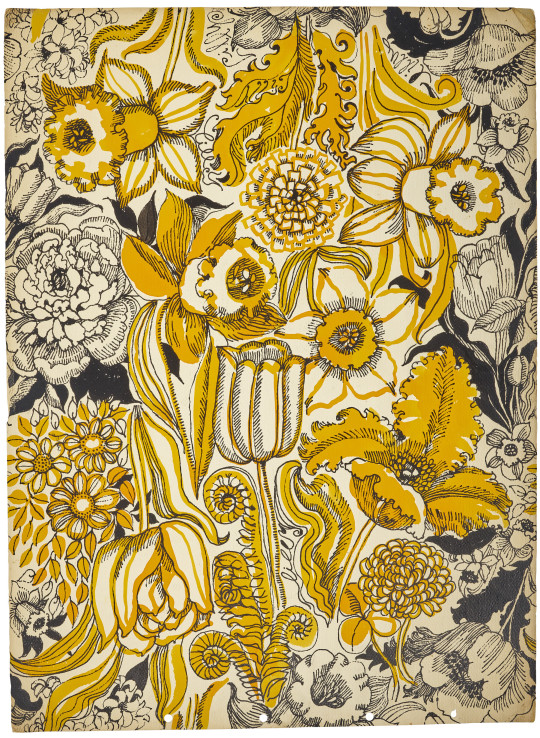
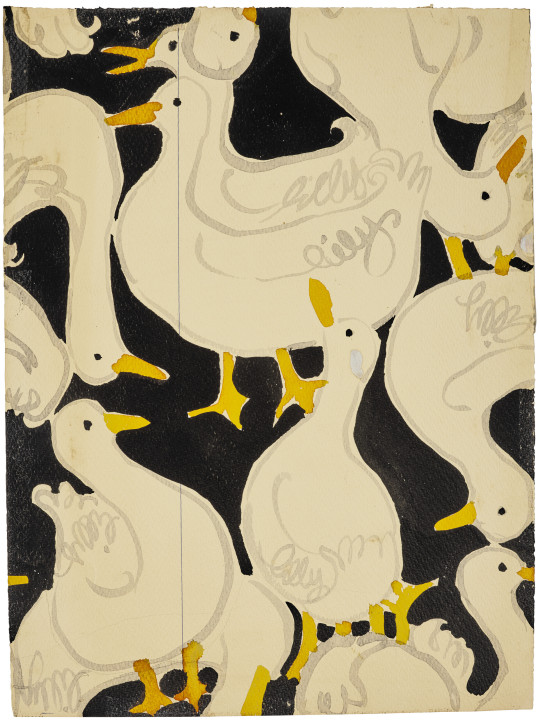



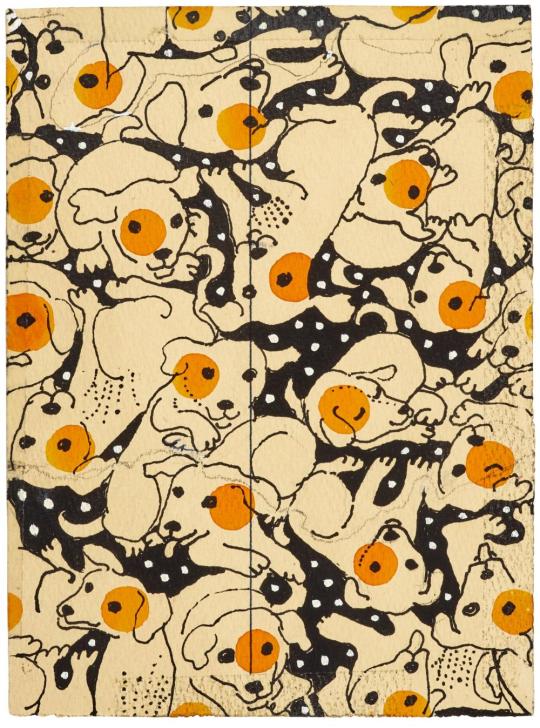
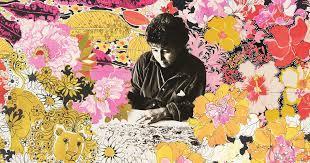
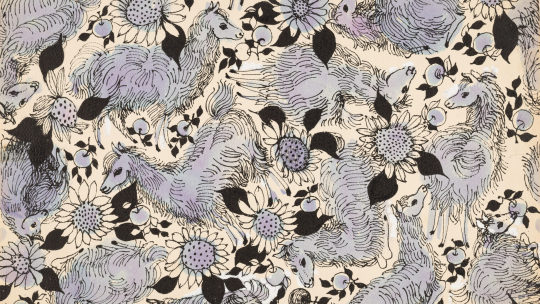
Textile designer SUZIE ZUZEK (American, 1920-2011)
“Suzie Zuzek is somebody whose work is familiar to millions of people, and who had a major impact on the social history and the material culture of the 1960s and ’70s, but most people have never heard her name,” said Cooper Hewitt textile curator Susan Brown.
"The road from basement obscurity to posthumous recognition was a long and winding one, spearheaded by a St. Louis lawyer named Becky Smith, who first encountered Zuzek’s designs while on the hunt for vintage upholstery fabric. She ended up in Key West and ran into Zuzek’s daughter, Martha, who shared her late mother’s story. Smith says she was captivated, and immediately made it her mission to bring the story to light: “What if your mom sat on the second floor of an art studio for a quarter of a century and created an iconic look through her creative genius and nobody knows her name?”
Born in 1920, Zuzek grew up on a dairy farm outside of Buffalo, New York. After serving in the Women’s Army Auxiliary Corps during World War II, she studied textile design and illustration at the Pratt Institute in Brooklyn. She graduated at the top of her class and worked for the New York-based fabric company Herman Blanc before relocating to Key West with her husband, from whom she separated not long afterwards. Eventually, she ended up with a job at Key West Hand Print Fabrics, a local outfit run by a group of former Broadway set designers.
“There are a lot of larger-than-life characters in the story, around her, but she herself was pretty quiet,” Brown said, recalling conversations she had with local residents for a short documentary that will accompany the exhibition. “I get the feeling she was more taciturn than shy. People say she had a really wicked sense of humour.”
https://www.wmagazine.com/.../suzie-zuzek-lilly-pulitzer...
64 notes
·
View notes
Text
Unlocking the Thrill: The World of Motorcycle Accessories
Motorcycling is more than just a mode of transportation; it's a lifestyle, an exhilarating journey that sparks a sense of freedom and adventure. For motorcycle enthusiasts, their bike isn't just a machine; it's an extension of their personality. To enhance the riding experience and add a touch of personal flair, motorcyclists often turn to a wide array of motorcycle accessories. These accessories not only boost functionality but also elevate the aesthetics, comfort, and safety of the rider. In this blog, we delve into the fascinating world of motorcycle accessories that cater to the needs and desires of riders worldwide.
Riding Gear: Safety First
The most crucial motorcycle accessories are the ones designed to protect the rider. High-quality riding gear, including helmets, jackets, gloves, and boots, forms the first line of defense on the road. A sturdy, well-fitted helmet is indispensable, guarding against head injuries and ensuring a safer ride. Additionally, leather or textile jackets, along with armored gloves and boots, provide protection against abrasions and impacts.
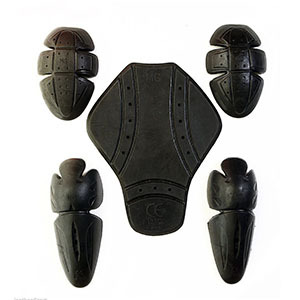
Performance Upgrades: Unleashing the Power
To unlock the true potential of their motorcycles, many riders invest in performance upgrades. Aftermarket exhaust systems enhance engine efficiency, improve sound, and boost overall performance. High-quality air filters and fuel management systems optimize fuel intake, leading to better fuel economy and power delivery. Performance upgrades not only make riding more thrilling but also reflect the rider's quest for improved performance.
Comfort Add-ons: Smooth Sailing
Long rides can put a strain on the rider's body, leading to discomfort and fatigue. Motorcycle enthusiasts often seek comfort add-ons to make their journeys more pleasant. Upgraded seats with extra padding or gel inserts provide improved support, reducing the impact of long hours on the saddle. Adjustable handlebars and foot pegs allow riders to find their perfect riding position, minimizing strain and enhancing overall comfort.
Luggage Solutions: Carrying Essentials
For those embarking on adventurous road trips or daily commutes, luggage solutions become a must-have accessory. Tank bags, saddlebags, and tail bags offer ample storage space for carrying essentials like clothes, gadgets, and tools. For added convenience, some riders opt for top box motorcycles with integrated storage compartments, offering a secure and easily accessible space for their belongings.
Lighting Enhancements: Illuminating the Path
Enhanced lighting solutions are popular motorcycle accessories, especially for riders who love exploring after dark. LED headlights and auxiliary lights offer improved visibility, illuminating the road ahead and increasing safety during nighttime rides. Customizing the lighting setup also allows riders to add a unique touch to their bikes' appearance.
Aesthetic Accents: Reflecting Personal Style
Motorcycle enthusiasts often take pride in customizing their bikes to reflect their individuality. Aesthetic accessories such as tank pads, decals, and graphic kits add a touch of personal flair to the motorcycle's design. Custom paint jobs, rim tapes, and colored brake calipers are other ways riders enhance the visual appeal of their bikes, making them stand out in a crowd.
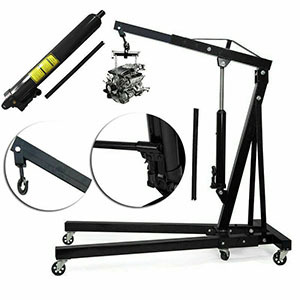
Conclusion:
Motorcycle accessories are more than just add-ons; they are the key to unlocking the true potential of a rider's journey. From safety gear to performance upgrades, comfort add-ons to aesthetic accents, these accessories cater to the diverse needs and desires of motorcyclists worldwide. As riders seek to elevate their riding experience, they find solace in the world of motorcycle accessories, where innovation and personalization intertwine to create a thrilling and unforgettable adventure on two wheels. Embracing the spirit of individuality and a quest for betterment, motorcycle accessories continue to evolve, enriching the lives of riders and igniting the passion for the open road.
2 notes
·
View notes
Text
#auxiliaries for textile industry in Delhi#textile auxiliaries manufacturers Delhi#textile auxiliary producer Delhi
0 notes
Text
Specialty Chemicals Chennai: Leading Innovative Military, Industrial and Economic Applications
Chennai is a pivotal region in India’s chemical industry owing to its burgeoning focus on specialty chemicals. These are high-value addressed performance chemicals designed for use in several sectors such as pharmaceuticals, agriculture, construction, automobiles, textiles, and electronics. There is rising demand for specialty chemicals from Chennai due to the developments in industries, robust infrastructure of the area, as well as, changed proximity to ports which enhance distribution activities.
Chennai specializes in other surfactants and epoxy esters used as sophisticated vision adhesives plasticizer which sets them apart from commodity based chemicals. As formulated during need based approach while substituting resin for emulsion throughout system undergoes pH change which enables them blend polypropylenes core-improved cycled stainable adhesive bonds providing advanced features ammonic amalgams thus enabling diverse applicability. With development industrial special technological remain vital emphasizing expanding produto service shorten happily sustain eco-friendly growth utilized.
The automotive industry is one of the most significant beneficiaries of specialty chemicals in Chennai. It is well known that Chennai’s “Detroit of India” nickname came from it being home to a number of automobile companies and suppliers to the industry. Specialty chemicals play an important role in coatings, lubricants, fuel additives, and sealants used in vehicles which need to meet performance and durability standards while being fuel-efficient. These chemicals also enhance the aesthetics of the vehicle while providing corrosion resistance and controlling emissions.
In construction, specialty chemicals are essential in creating high-performance concrete as well as waterproofing adhesives and protective coatings. In Chennai's coastal climate, super plasticizers, curing compounds, and fiber reinforced additives help make structures more durable and resilient to damage. There is currently a shift towards green construction which places value on environmentally sustainable building practices with low VOC specialty chemicals gaining traction.
Specialty Chemicals are also critical for formulated fertilizers and soil conditioners as well as adjuvant for pesticides which increase productivity agriculturally and preserve soil health. With biocides, coagulants, anticipants and flocculants providing safe water for household use and industrial requirements these tailored water treatment solutions ensure stringent environmental compliances are met. These customized substances aid industries in Chennai fulfill the strict environment compliance regulations alongside bolstering agriculture while conserving.
The textile and leather processing industries located in and around Chennai make significant use of auxiliary specialty chemicals. These chemicals are key for dyeing, finishing, flame retardation, and water repellency, which improve the appearance, functionality, and safety of textiles as well as garments. In leather processing, quality tanning agents and surface coatings that meet international standards bolster quality and durability.
Ongoing advances in research and development are continuously evolving specialty chemicals to address complex modern applications. Global businesses are competing with local manufacturers in innovation while sustainability is a common focus on bio-based materials, nanotechnology, and green chemistry.
Without a doubt, Specialty chemicals Chennai are important assets to the industrial ecosystem of the city. They aid in achieving greater efficiency while also supporting environmental targets across numerous sectors. The region’s economic growth is sure to benefit from innovations driven by the expanding demand—and thus supply—for more customized offerings tailored to the needs of users provided by Chennai’s specialty chemical industry.
0 notes
Text
0 notes
Video
youtube
Mercedes AMG GT XX Concept - Full Tech Specs and Performance
Mercedes-AMG presents the GT XX Concept, a four-door performance sedan previewing its first dedicated electric model on the AMG.EA platform.
At the heart of the GT XX is a tri-motor setup featuring advanced axial-flux technology. Two motors are mounted on the rear axle, and a third drives the front. This configuration enables fully variable AMG Performance 4MATIC+ all-wheel drive, with the front motor decoupling when not needed for optimal efficiency.
Combined output exceeds 1,341 horsepower, with the car capable of accelerating beyond 223 mph. The rear motors each include a planetary gearset, water-cooled inverter, and oil cooling to ensure durability under sustained high-performance use.
Power is supplied by a newly engineered high-performance battery. It features cylindrical NCMA cells with silicon-enhanced anodes and a laser-welded aluminum housing. Direct cell cooling via non-conductive oil ensures thermal stability and repeatable peak output.
The 800-volt system supports ultra-fast charging at over 850 kW, enabling up to 400 kilometers of range to be recharged in approximately five minutes.
The GT XX’s chassis is built on a lightweight aluminum-steel composite matrix, with the battery centrally integrated for added stiffness and crash safety.
Aerodynamically, the concept achieves a drag coefficient of just 0.198. Active aerodynamic elements include a movable front splitter, side air curtains, and 21-inch forged wheels with carbon-fiber aero panels. These panels adjust based on cooling needs and are powered by energy recovered from wheel motion.
The exterior design features a low, coupe-like silhouette with a sharply raked windscreen, no rear window, flush door handles, and bold side skirts. At the front, an illuminated AMG grille is paired with stacked LED headlights and integrated auxiliary lighting. The rear includes pronounced haunches, an active airbrake, a carbon-fiber diffuser, and triple circular LED tail lights.
Lighting technology plays a key role, with over 700 RGB LEDs in the MBUX Fluid Light Panel capable of displaying data and effects. Exterior speakers embedded in the headlights can project a simulated AMG V8 sound profile.
Inside, the GT XX Concept features a minimalist, performance-focused cockpit. A 10.25-inch digital instrument display and a 14-inch MBUX touchscreen dominate the center console. The flat-top AMG One-style yoke includes paddles to control regenerative braking modes.
Lightweight carbon-fiber bucket seats include 3D-printed padding and are upholstered in LABFIBER—a sustainable material derived from recycled GT3 tires and biopolymer textiles. Orange-accented structural elements and exposed tubing contribute to the high-tech, motorsport-inspired interior design.
The AMG GT XX Concept represents Mercedes-AMG’s next step toward electrified performance. With cutting-edge propulsion, battery, and aerodynamics, it sets the tone for AMG’s future in the era of high-performance electric mobility.
0 notes